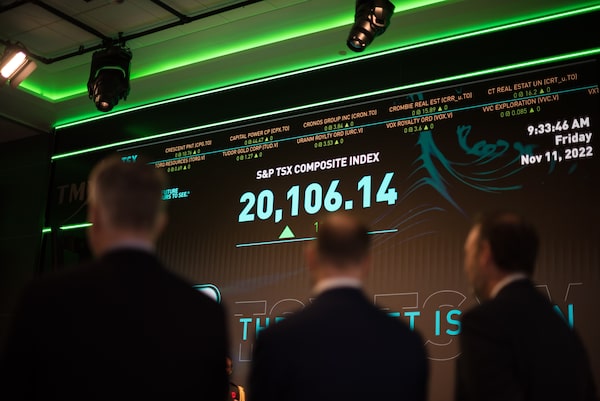
The S&P/TSX composite index screen at the TMX Market Centre in downtown Toronto. Critics say tax rules that provide Canadian-controlled private corporations with access to incentives are not available to public companies and creates artificial barriers to growth.Tijana Martin/The Canadian Press
Canada has been the worst-performing advanced economy in the Organization for Economic Co-operation and Development since 1976. Governments of all partisan stripes have tried and failed to reverse the trend. If nothing changes, the OECD projects, our economic growth per capita will continue to stagnate for decades to come. This article is part of an occasional series called Per Capita, which examines how and why policy interventions have come up short – and how fresh approaches to economic growth are urgently needed.
When Andrew White took his company public on the TSX Venture Exchange in 2016, he was more focused on what he stood to gain than what he stood to lose.
But once CHAR Technologies Ltd. YES-X was no longer a private corporation, he discovered that major tax benefits – incentives for scientific research and experimental development (SR&ED) being key among them – were no longer available to his business.
That’s because Canada’s tax rules provide Canadian-controlled private corporations (CCPCs) with access to incentives that are not available to public companies – a policy that capital markets experts say creates artificial barriers to growth.
“I didn’t totally realize [SR&ED] would disappear,” Mr. White, CHAR’s co-founder and chief executive officer, said in an interview.
He would have taken his company public regardless, he said, but he questioned why a company like his – which turns forestry waste products into renewable energy – should be “penalized” for going public.
TMX Group Ltd. X-T, which operates Canada’s largest stock exchanges, including the TSX and TSXV, has spent years lobbying to change those tax rules. More recently, that effort has taken on a renewed sense of urgency as a growing chorus of experts warn of Canada’s malignant labour productivity trends.
Preventing public companies from accessing incentives that encourage more spending on research and development is making the job of reversing those trends more difficult, TMX argues. CHAR is a case in point, as Mr. White said regaining access to the SR&ED credit system would allow him to hire six more R&D-focused employees over the next five years.
The reason he can’t, according to TMX Group CEO John McKenzie, is because Canadian policy makers harbour an inaccurate view of the country’s public companies.
“It is a lack of knowledge and understanding and a bias around public companies being big companies,” Mr. McKenzie said in an interview.
Governments may “want a policy to just help small businesses, so they will make it applicable to Canadian-controlled private corporations without recognizing that two-thirds of our public listings are small and medium-sized enterprises.”
Beware risk of ‘mutually sabotaging competition’ on corporate subsidies: Freeland
Data from S&P Capital IQ and the TMX Group’s internal sources show that of 2,284 companies listed on the TSX and TSXV, 1,489 have fewer than 250 employees, representing 65 per cent of the total. While the vast majority of those companies – 1,350 – are listed on the TSXV, where issuers are generally smaller, that still leaves 139 companies on the senior TSX exchange with fewer than 250 employees, or 18 per cent of the total.
Statistics Canada considers any company with fewer than 500 employees a medium-sized business and any company with fewer than 100 employees a small business.
The unintended consequence of tax policies that withhold certain benefits to public companies, Mr. McKenzie said, “is that if I’m a private company that gets those credits today, if I want to raise new public money to expand and grow what I’ve built, then I’ve got an extra cost of raising that public money.”
“We’ve been raising this issue for a number of years now without seeing any progress on it getting addressed.”
For its part, the government at least appears to be aware of the issue. In the past two federal budgets, Ottawa has pledged to review the SR&ED program in particular.
“There may be some changes coming,” said Brian Ernewein, a senior adviser at the national tax centre of KPMG in Canada who previously spent 35 years working in the tax policy branch of the federal Ministry of Finance. “But as the law stands, there is quite a sharp distinction between the benefits you get as a CCPC and a listed company.”
With SR&ED, for example, as much as 35 per cent of what a private Canadian company spends on R&D can qualify for an investment tax credit, with some or all of that amount refundable in the form of cash payments directly to the company. For public companies – or private companies that are not Canadian-controlled – the rate tops out at 15 per cent and is not refundable.
“That means you can only use it against taxes payable,” Mr. Ernewein said. “So if you are still in the growth phase and are not generating taxable income, then even that 15 per cent credit may not be accessible to you.”
For Mr. McKenzie, that sharp distinction only reinforces the need to understand that Canada’s public companies tend to skew smaller than those of other capital markets around the world.
“This is unique to the Canadian model, and we want to make sure governments of all sizes appreciate that,” he said.
Failure to acknowledge that reality, he said, could lead to major policy miscalculations. During the early days of the pandemic, for instance, the original version of the employee wage subsidy program was only going to allow private companies to qualify, he said, “and we lobbied for that to include public companies.”
Part of the difficulty lies in the way different government departments define small and medium-sized businesses. Statscan uses the number of employees, but the Canada Revenue Agency uses income levels and asset values for tax purposes.
No distinctions are made between public or private companies for statistical or taxation purposes, which means a large private company with millions of dollars in annual income can access tax benefits that a small prerevenue public company cannot.
As long as Canadian tax policy draws such a sharp distinction between private and public companies when it comes to innovation-related incentives, Mr. McKenzie argues, the problem is only going to get worse.
“At various stages of dialogue, we have about 1,600 companies that are in our pipeline of private companies that could raise public capital, and half of them are technology companies that this will be directly relevant for,” he said. “And part of the challenge is that most of these prepublic companies are not even thinking about the tax implications of them going public.”
Those implications can range far beyond the taxes companies pay or the credits they receive. In 2021, for example, Ottawa changed the rules governing how companies grant stock options to their employees, effectively providing tax benefits to employees who receive stock options from a CCPC but not to employees of a public company.
“A small-cap company can’t afford the big salary for the tech people they’re trying to get, but they can afford a big option program,” Mr. McKenzie said. “But [that change] was going to make it hard for small companies – particularly those in the innovation economy – to attract talent.”
TMX lobbied for an exemption for smaller companies, he said, and eventually the government limited the new rules to option packages worth more than $200,000.
“These are the kinds of things that we are constantly trying to help officials to understand,” Mr. McKenzie said. “There is no other market in the world that has this well-developed public ecosystem for small-cap companies, but if government policy doesn’t understand that, then we can create artificial barriers for companies looking to use it to fund growth.”
 Jameson Berkow
Jameson Berkow